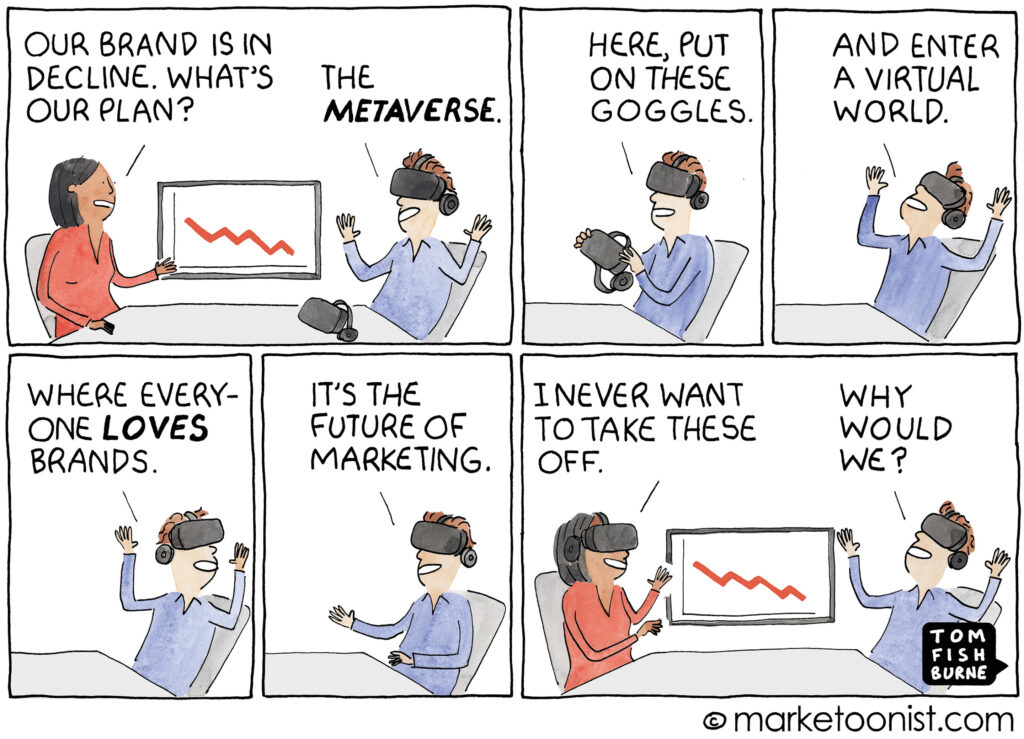Imagine a futurized virtual world where consumer spending shifts to virtual goods, services, and experiences…
…all powered by virtual labor.
What is the “Metaverse?”
The term first appeared in the book “Snow Crash,” by writer Neal Stephenson in 1992. The metaverse term refers to a fully immersive digital/virtual environment where people interact as avatars.
You can see a glimpse of the metaverse today in online games like Fortnite, SimCity, Minecraft, and the advancement of augmented reality and VR devices like Facebook’s Oculus headsets.
This just in…
…Facebook just announced a $50 million fund to help develop the metaverse “more responsibly,” (whatever that means.)
Facebook defines the elusive metaverse as “virtual spaces where you can create and explore with other people” that you’re not physically with, spread out over a variety of products and services.
Could this be the future state of, or even successor to, today’s internet and digitally connected economy?
But, what about marketing in the metaverse?
In a virtual economy, what’s real?
Is it just me or does it seem that the world yearns to leave the physical state of existence, (and the hopes, dreams, desires, fears, that come with it), and transform it into a perpetual state of digitized virtual reality?
Since marketers and brands love to be where people are—what to do when they’re all virtual?
Maybe we’ll be able to create “virtual demand” for “virtual audiences” so we can control the “virtual economic outcome.”
And yearn to live in the coming Marketing Matrix!
After all, marketing is just a game for most of the buzzards out there that view it as such.
Just imagine the “virtual metrics” you can dream up!
Infinite impressions, clicks, and likes—all leading to “virtual commerce” of worthless virtual currency.
Downright scary, ain’t it?
NFTs
Since we’re talking about the metaverse, we must have a quick chat about NFTs, (non-fungible tokens.)
First of all, I take great joy in the fact that the word “fungible” has been added to this word, an ironic twist to the “interchangeable commodities” context as it relates to “value” (more on that below.)
A non-fungible token is a unit of data stored on a digital ledger, called a blockchain, that certifies a digital asset to be unique and therefore not interchangeable. NFTs can be used to represent items such as photos, videos, audio, and other types of digital files.
NFTs are selling these days for huge piles of money, (one just sold for $69.3 million at Christie’s, the first time the historic auction house has ever sold a purely digital piece of art.)
So, here’s the meta-question…
…what defines value in the coming virtual economy?
Take the recent sale of CryptoPunk #7523 which just sold for $11.8 million.
As Warren Buffet famously stated, “price is what you pay, value is what you get.”
The inherent wisdom here implies that price and value are not always one and the same.
The “what you get” refers to the intrinsic value, a way of describing the perceived or true value of an asset.
In the case of multimillion-dollar NFT sales, the perceived value here is the “beauty is in the eye of the beholder” definition.
For NFTs, it’s all about the scarcity principle, where the creators use the principle to create artificial scarcity to generate high demand and even higher prices for the right to own it.
Maybe that’s the holy grail and future of marketing—artificial scarcity in our world of digital abundance.
Limited supply, high demand, and higher prices.
Sound familiar? Stay unruly.
